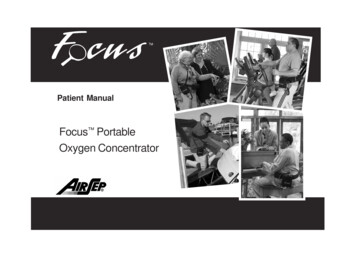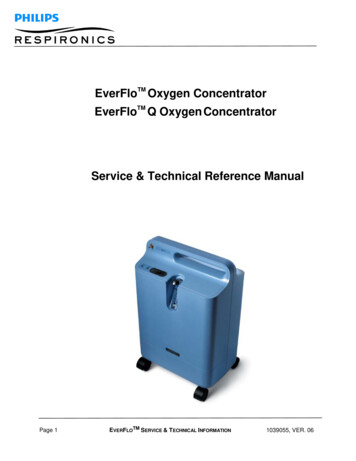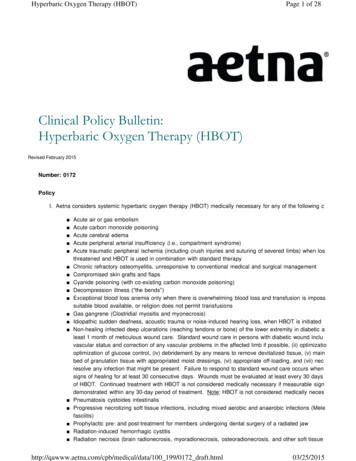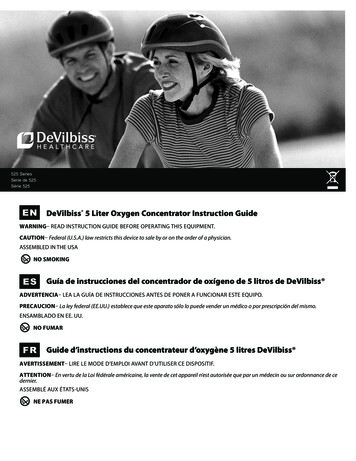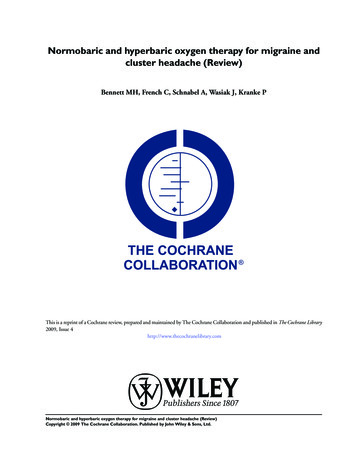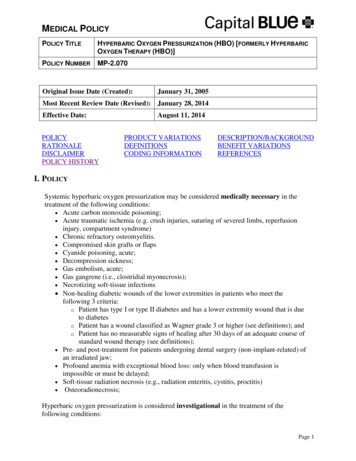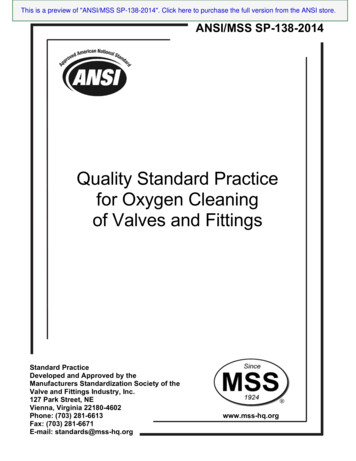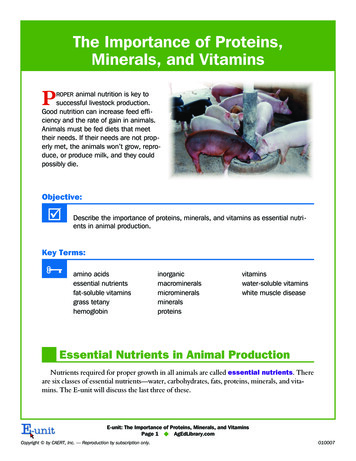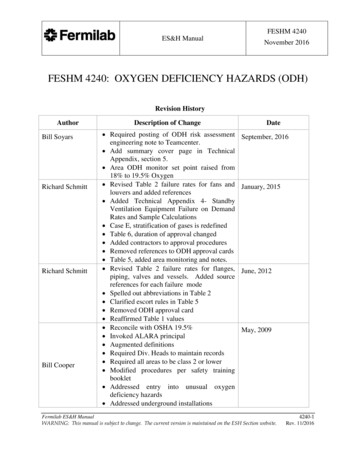
Transcription
FESHM 4240ES&H ManualNovember 2016FESHM 4240: OXYGEN DEFICIENCY HAZARDS (ODH)Revision HistoryAuthorBill SoyarsRichard SchmittRichard SchmittBill CooperDescription of Change Required posting of ODH risk assessmentengineering note to Teamcenter. Add summary cover page in TechnicalAppendix, section 5. Area ODH monitor set point raised from18% to 19.5% Oxygen Revised Table 2 failure rates for fans andlouvers and added references Added Technical Appendix 4- StandbyVentilation Equipment Failure on DemandRates and Sample Calculations Case E, stratification of gases is redefined Table 6, duration of approval changed Added contractors to approval procedures Removed references to ODH approval cards Table 5, added area monitoring and notes. Revised Table 2 failure rates for flanges,piping, valves and vessels. Added sourcereferences for each failure mode Spelled out abbreviations in Table 2 Clarified escort rules in Table 5 Removed ODH approval card Reaffirmed Table 1 values Reconcile with OSHA 19.5% Invoked ALARA principal Augmented definitions Required Div. Heads to maintain records Required all areas to be class 2 or lower Modified procedures per safety trainingbooklet Addressed entry into unusual oxygendeficiency hazards Addressed underground installationsDateSeptember, 2016January, 2015June, 2012May, 2009Fermilab ES&H ManualWARNING: This manual is subject to change. The current version is maintained on the ESH Section website.4240-1Rev. 11/2016
FESHM 4240ES&H Manual November 2016Revised introduction to include ALARAClarified that ODH is based on fatalityReformatted equationsEliminated classes 3 and 4Fermilab ES&H ManualWARNING: This manual is subject to change. The current version is maintained on the ESH Section website.4240-2Rev. 11/2016
FESHM 4240ES&H ManualNovember 2016TABLE OF CONTENTS1.0 INTRODUCTION . 42.0 APPLICABLE STANDARDS . 43.0 DEFINITIONS . 44.0 SPECIAL RESPONSIBILITIES . 55.0 PROCEDURES. 66.0 TECHNICAL APPENDIX . 96.1 ODH RISK ASSESSMENT .9Figure 1, Fatality Factor . 11Table 1, Fermilab Equipment Failure Rate Estimates . 12Table 2, Equipment Failure Rate Estimates . 13Table 3, Human Error Rate Estimates . 18A. ODH Assessment Equations. 19B. ODH Hazard Classes . 22Table 4, Oxygen Deficiency Hazard Class . 226.2 ODH CONTROL MEASURES .24Table 5, ODH Control Measures . 25Figure 2 - ODH signs . 29Table 6, Levels of ODH Medical Approval . 30Procedures to Obtain ODH Medical Approval from the Medical Department . 30Figure 3 - Emergency evacuation and rescue flowchart . 336.3 REFERENCE MATERIALS FOR OXYGEN DEFICIENT HAZARDS .34Effects of Exposure to Reduced Atmospheric Oxygen . 34Table 7, Effect Thresholds for Exposure to Reduced Oxygen . 35Figure 4, Time to Unconsciousness . 35Figure 5, Other Effects of Oxygen Concentration . 36Rationale for Table 1: “Fermilab Equipment Failure Rate Estimates” . 376.4STANDBY EQUIPMENT FAILURE ON DEMAND AND SAMPLECALCULATIONS .406.5 ODH ANALYSIS COVER PAGE.54Fermilab ES&H ManualWARNING: This manual is subject to change. The current version is maintained on the ESH Section website.4240-3Rev. 11/2016
FESHM 4240ES&H ManualNovember 20161.0 INTRODUCTIONThe use of compressed and liquefied gases is commonplace at Fermilab. The introduction ofthese materials to the atmosphere can present a hazard. In particular, persons exposed toreduced-oxygen atmospheres may experience reduced abilities, unconsciousness, or death. Thepurpose of this chapter is to specify requirements for assessing the potential for and controllinghazards associated with a possible oxygen deficient environment. This chapter does not addressthe general topic of confined spaces (see Chapter 4230 and definition of "ODH operation"below).This chapter cannot be used in lieu of requirements set forth by other industry standards, such asdescribed in FESHM Chapter 5035 Mechanical Refrigeration Systems per ASHRAE 15 orFESHM Chapter 6020.3 addressing storage and usage of flammable gases. However, this chapterdoes not preclude concurrent use if hazard assessment deems it necessary2.0 APPLICABLE STANDARDSAmerican Conference of Governmental Industrial Hygienists (ACGIH) 2005 Threshold LimitValues (TLVs) for Chemical Substances and Physical Agents & Biological Exposure Indices(BEIs) – Minimal Oxygen Content3.0 DEFINITIONSALARA (As Low As Reasonably Achievable) - The approach to protection from hazards bymanaging and controlling exposure to potential hazards (both individual and collective) to thework force and to the general public at levels as low as is reasonable, taking into account social,technical, economic, practical and public policy considerations. As used in this Manual,ALARA is not a hazard limit but a process which has the objective of reducing hazards as farbelow the applicable limits as is reasonably achievable.mmHg - a unit of measure of pressure based upon a liquid mercury column. The pressureexerted by gravity at the base of a liquid mercury column n mm tall is n mmHg.ODH Monitor - a device, usually permanently attached to a structure, which monitors theconcentration of oxygen and alarms at a set value. ODH monitors must be set to alarm at 19.5%oxygen or higher and can be used to activate other systems.Operations - activities, which are performed in a specific area or location. Operations includesimply being in a specific location.Oxygen concentration - the molar fraction of a gaseous mixture represented by oxygen. For amixture of ideal gases, it is also equal to the ratio of the partial pressure of oxygen to the totalmixture pressure. The oxygen concentration in normal ambient atmosphere is 20.9% ( 21%).Fermilab ES&H ManualWARNING: This manual is subject to change. The current version is maintained on the ESH Section website.4240-4Rev. 11/2016
FESHM 4240ES&H ManualNovember 2016Oxygen deficiency - any condition under which the partial pressure of atmospheric oxygen isless than 144 mmHg (about 19.5% by volume at a barometric pressure of 740 mmHg atFermilab).Oxygen deficient area - any area known to have an oxygen deficiency.Oxygen deficiency hazard (ODH) operation - an operation which exposes personnel to anincreased risk of fatality in excess of 10-7/hr due to oxygen deficiency. Unlike confined spaces,ODH work spaces are generally designed for occupancy and provided with normal building-typeaccess and egress. In addition, the hazard is primarily limited to oxygen deficiency which is wellunderstood and controlled through quantitative risk assessment.Partial pressure - the pressure due to one of several components of a gaseous mixture. For amixture of ideal gases, the sum of component partial pressures equals the mixture pressure.Personal Oxygen Monitor - a device carried by an individual that monitors the concentration ofoxygen and alarms at a set value. All personal Oxygen Monitors used at Fermilab are set toalarm at the mandatory confined space limit of 19.5% (see Chapter 4230).SCBA (Self-Contained Breathing Apparatus) - a device worn by rescue workers, firefighters, andothers to provide breathable air in a hostile environment. An SCBA typically has three maincomponents: a high-pressure tank (e.g., 2200 psi to 4500 psi), a pressure regulator, and aninhalation connection (mouthpiece, mouth mask or face mask), connected together and mountedto a carrying frame.Self-Rescue supplied atmosphere respirator (escape pack) - a device containing breathing air tobe used for escape during an ODH event. Such a device normally provides an air supply whichlasts approximately five minutes and is to be used for escape only.4.0 SPECIAL RESPONSIBILITIESDivision/Section heads or their designees have the responsibility of implementing therequirements of this chapter. This includes appointment of qualified persons to review, approve,and maintain documentation for ODH risk assessments under the control of their organizations;maintain records of reliability of ODH-associated equipment; and maintain records of incidentswhich have resulted in an oxygen deficient atmosphere. The risk assessment Engineering Noteshall be placed into Teamcenter.Division/Section heads or their designees shall certify compliance with this chapter by approvingthe risk assessment Engineering Note. The Teamcenter Workflow may be used to electronicallyobtain the required approvals and release the Engineering Note. Alternatively, approvals mayalso be obtained by physical signature, scanned, and included with the Engineering Note. ATeamcenter Workflow must still be completed so that the Engineering Note is released. Thisworkflow need not involve the required approvers in the case of physical signature.Fermilab ES&H ManualWARNING: This manual is subject to change. The current version is maintained on the ESH Section website.4240-5Rev. 11/2016
FESHM 4240ES&H ManualNovember 2016The ESH&Q Section has the responsibility for the purchase and maintenance of personal oxygenmonitors and the provision of standardized warning signs as described in the TechnicalAppendix to this document. In addition,The Occupational Medical Office is responsible for reviewing the medical fitness of persons whoparticipate in ODH operations.The Cryogenic Safety Subcommittee and/or the Mechanical Safety Subcommittee servedivision/section heads and the ESH&Q Section in a consulting capacity on ODH risk assessmentissues.The Industrial Hygiene Group of ESH&Q provides oversight and consulting on the technologiesand procedures for monitoring oxygen deficient atmospheres.5.0 PROCEDURES1. A quantitative assessment of the increased risk of fatality from exposure to reducedatmospheric oxygen shall be conducted for all operations, which are physically capable ofexposing individuals to an oxygen deficiency. This assessment shall assign an OxygenDeficiency Hazard Class to each area with potential risk as well as specify any unusualprecautionary requirements. The classification of an area can change depending on theoperations being performed. If conditions and/or activities change in ways that significantlyincrease the risk, the associated quantitative assessment must be accordingly revised,reviewed and approved. The technical appendix entitled "ODH Risk Assessment" is to beused in carrying out the assessment.2. Control measures appropriate to the ODH Class shall be implemented as stated in the riskassessment and Technical Appendix. ODH Class 0 is the least hazardous. ODH Class 2 is themost hazardous. The technical appendix entitled "ODH Control Measures" is to be followedto control the potential ODH hazard.3. Equipment at Fermilab shall be designed and installed (engineered) to ensure that areasintended for human entry during normal operation will be ODH Class 0, ODH Class 1, orODH Class 2. No area intended for human entry during normal operation will be engineeredfor an ODH Class higher than 2. For Confined Space requirements (not under the scope ofthis chapter), see Chapter 4230.3.1. If an area cannot be engineered to satisfy requirements leading to an ODH Class of 2 orlower, the Division/Section Head responsible for the area must submit a writtenexception request to the Director or Director’s designee. The request should include ajustification and an evaluation of hazards, procedures, and safety measures. The requestmust be approved by the Director or designee before operations contributing to oxygendeficiency hazards are begun.4. The ALARA principle shall be applied. Occupancy of areas with oxygen deficiency hazardsFermilab ES&H ManualWARNING: This manual is subject to change. The current version is maintained on the ESH Section website.4240-6Rev. 11/2016
FESHM 4240ES&H ManualNovember 2016should be limited to the extent practical while still allowing work to be performedexpeditiously. Work in such areas should be planned to minimize the duration of occupancy.Offices should not be located in areas with oxygen deficiency hazards.5. Divisions/Sections should maintain records of reliability of ODH-associated equipment andrecords of ODH alarms that were the result of an oxygen deficient atmosphere. These datashould be periodically reviewed by the Cryogenic Safety Subcommittee to improve failurerate estimates such as those included in the Technical Appendix to this chapter.6. Response to an alarm from a personal oxygen monitor:6.1. If one person is working alone in an area and his/her personal oxygen monitor alarms,the person must immediately don a self-rescue supplied atmosphere respirator (escapepack), evacuate the area, and dial 3131 to report an emergency.6.2. If two or more people are working together in an area and a personal oxygen monitoralarms, they should compare readings. If other monitors read OK, then everyone mustevacuate the area and solve the problem with the personal oxygen monitor before reentering. If other monitors confirm low oxygen levels, then everyone must don an escapepack, evacuate the area, and then dial 3131 to report an emergency.7. Response to an alarm from an in-place oxygen monitor:7.1. If one person is working alone in an area and an in-place oxygen monitor alarms, andhis/her personal oxygen monitor reads greater than 19.5%, the person should evacuatethe area going away from the assumed source of the alarm. After exiting, he/she shouldnotify the operations department responsible for the area of the problem. He/she shouldnot re-enter until the problem has been solved. If a personal oxygen monitor has alarmedas well, the procedure of 6.1 should be followed.7.2. If two or more people are working together, they should compare readings of personaloxygen monitors. If all personal oxygen monitors read OK, everyone should evacuatethe area going away from the assumed source of the alarm. After evacuating, they shouldnotify the operations department responsible for the area of the problem. They shouldnot re-enter the area until the problem has been solved. If a personal oxygen monitorconfirms low oxygen levels, everyone should don an escape pack, evacuate the area, andthen dial 3131 to report an emergency.8. Response to other indications of a possible cryogen or gas leak (vapor cloud, sound of gasleak, etc.):8.1. If one person is working alone and his/her personal oxygen monitor reads greater than19.5%, he/she should evacuate the area going away from the assumed source of theproblem. After exiting, he/she should notify the operations department responsible forthe area of the problem. If a personal oxygen monitor has alarmed, he/she mustFermilab ES&H ManualWARNING: This manual is subject to change. The current version is maintained on the ESH Section website.4240-7Rev. 11/2016
FESHM 4240ES&H ManualNovember 2016immediately don a self-rescue supplied atmosphere respirator (escape pack), evacuatethe area, and dial 3131 to report an emergency.8.2. If two or more people are working together, they should compare personal oxygenmonitor readings. If all are OK, they should all evacuate the area going away from theassumed source of the problem. After exiting, they should notify the operationsdepartment responsible for the area of the problem. If a personal oxygen monitor hasalarmed, they must immediately don self-rescue supplied atmosphere respirators (escapepacks), evacuate the area, and dial 3131 to report an emergency.9. Entry into an area with unusual oxygen deficiency hazards:9.1. Any rescue must be conducted by emergency (Fire Department) personnel. If an area issuspected to be oxygen deficient or to present an elevated risk for oxygen deficiencyhazards, an unexposed observer and the use of SCBA equipment are required. Trainingand medical approval are required for the use of SCBA equipment.9.2. If, for purposes other than rescue, entry must be made into an oxygen deficient area oran area suspected to present an elevated risk for oxygen deficiency hazards, theDivision/Section Head responsible for the area must submit a written request to theDirector or Director’s designee which includes a justification and outlines hazards,procedures, and safety measures. The request must be approved by the Director ordesignee before entry.10. In general, ODH evaluation procedures and measures to address hazards in undergroundinstallations are the same as those required for surface installations. However, time of egressmay be longer, inerting gases or cryogenic fluids may accumulate, and rescue operations maybe more difficult. All of these factors must be taken into account in analyses and protectivemeasures.10.1. If there are oxygen deficiency hazards and normal entry and egress is by means otherthan by foot, at least one egress path to a “safe area” which can be reached by footmust be provided. The safe area must be free of oxygen deficiency hazards andremain so during all plausible equipment failures. If the safe area relies uponventilation, emergency power must be provided to its ventilation systems.10.2. The path to the safe area must be adequately marked and illuminated and remain freeof obstructions during plausible ODH incidents.10.3. A written plan for evacuation of personnel from the safe area to the surface must beprepared and approved.Fermilab ES&H ManualWARNING: This manual is subject to change. The current version is maintained on the ESH Section website.4240-8Rev. 11/2016
FESHM 4240TAES&H ManualNovember 20164240TA6.0 TECHNICAL APPENDIX6.1 ODH RISK ASSESSMENTThe ALARA principle is to be applied to all areas with oxygen deficiency hazards. Any areaknown to have an oxygen concentration 19.5% is considered to be an oxygen deficient area. Allareas intended for human occupancy at Fermilab shall have an environment or environmentalcontrols which will normally ensure that the concentration of oxygen remains above19.5%. If anarea contains equipment or sources of inert gas which could lead to a significant decrease inoxygen concentration, additional measures shall be taken to reduce risk to personnel. The goalsof an ODH risk assessment are to evaluate the level of risk in a given area, to classify the areabased upon the level of risk, that is, to assign an ODH Class to the area, and to specify additionalsafety measures to be taken to reduce risks.The ODH risk assessment shall be documented in Teamcenter, reviewed, and approved as notedin Chapter 4240 under “Special Responsibilities”. A summary cover page, as given in TechnicalAppendix Section 5 shall be used.The ODH Class is based upon the most severe risk: the likelihood that a fatality will occur. Sincethe level of risk is tied to the area and the nature of the operation, the fatality rate shall bedetermined on an operation-by-operation basis. For a given area and operation several eventsmay cause an oxygen deficiency. Each event has an expected rate of occurrence and eachoccurrence has an expected probability of causing a fatality. The oxygen deficiency hazardfatality rate is defined as:n Pi Fii 1where the ODH fatality rate (per hour),Pi the expected rate of the ith event (per hour), andFi the probability of a fatality due to event i.The summation shall be taken over all events which may cause oxygen deficiency and result infatality. When possible, the value of Pi shall be determined by operating experience at Fermilab;otherwise data from similar systems elsewhere or other relevant values shall be used. Equipmentfailure rate estimates are given inFermilab ES&H ManualWARNING: This manual is subject to change. The current version is maintained on the ESH Section website.4240TA-9Rev. 11/2016
FESHM 4240TAES&H ManualNovember 2016Table 1 and Table 2.Fermilab ES&H ManualWARNING: This manual is subject to change. The current version is maintained on the ESH Section website.4240TA-10Rev. 11/2016
FESHM 4240TAES&H ManualNovember 2016Table 1 contains median estimates collected from past ODH risk assessments at Fermilab (seeTechnical Appendix Section 3). Table 2 contains values derived from the nuclear power industryand industrial records. Human error rate estimates are presented in Table 3.The risk assessment should also consider the benefit of existing active control systems such asforced ventilation or any supply shut-off valves which are automatically activated by areamonitor readings or system failure indicators. These systems must be designed to be activatedbefore the area drops below 19.5% oxygen concentration. Although such systems or any forcedventilation system reduces overall risk, they are also subject to failure and this shall be factoredinto the risk assessment. This is accomplished by summing the expected failure rate of allsystems and the corresponding fatality factors for when those systems have failed. For example,a fan which is triggered by a low oxygen monitor reading may not function properly because of apower failure, inadequate maintenance, or the monitor's calibration drifting. Therefore, theprobability that these failures will occur and compromise the ventilation system shall be factoredinto the overall risk assessment. Also, since the calculation for defining ODH hazard is basedon untrained personnel using no special personal protection, the risk assessment must assumethat personnel take no direct action in responding to ODH conditions. For example, cannot bereduced by assuming a person hearing an alarm will exit.The value of Fi is the probability that a person will die if the ith event occurs. The value dependson the oxygen concentration. For convenience of calculation, an approximate relationshipbetween the value of Fi and the lowest attainable oxygen concentration has been developed(Figure 1). The lowest attainable concentration is used, rather than an average, since thatminimum value is conservative and the time dependence of the concentration is normally notwell known. If the lowest oxygen concentration is greater than 18%, then the value of Fi is zero,that is, all exposures above 18% are defined to be "safe" and to not contribute to fatality. (Note,this does not affect alarm set points. Alarms are generated at 19.5% O2 concentration.) It isassumed that all exposures to 18% oxygen or lower do contribute to fatality and the value of Fi isdesigned to reflect this dependence. If the lowest attainable oxygen concentration is 18%, thenthe value of Fi is 10-7. This value would cause to be 10-7 per hour if the expected rate ofoccurrence of the event were 1 per hour. At decreasing concentrations, the value of Fi shouldincrease until, at some point, the probability of fatality becomes unity. That point was selected tobe 8.8% oxygen, the concentration at which one minute of consciousness is expected.This curve applies only to inert gases; for other gases, physiological changes must beaddressed on a case-by-case basis.Fermilab ES&H ManualWARNING: This manual is subject to change. The current version is maintained on the ESH Section website.4240TA-11Rev. 11/2016
FESHM 4240TAES&H ManualNovember 2016Figure 1, Fatality FactorGraph of the logarithm of the fatality factor (Fi) versus the lowest attainable oxygenconcentration which can result from a given event. This relationship should be used when nobetter estimate of the probability of fatality from a given event is available. This relationshipassumes inert gas displacing oxygen, with no other physiological influence from the gas itself.Fermilab ES&H ManualWARNING: This manual is subject to change. The current version is maintained on the ESH Section website.4240TA-12Rev. 11/2016
FESHM 4240TAES&H ManualNovember 2016Table 1, Fermilab Equipment Failure Rate EstimatesSystemFailure ModeFailure RateCompressorLeak5 x 10-6/hr(Two-stage Mycom)Component rupture3 x 10-7/hrDewarLoss of vacuum1 x 10-6/hrElectrical Power FailureTime Rate1 x 10-4/hr(unplanned)Demand Rate3 x 10-4/DTime Off1 hrFluid LineLeak5 x 10-7/hr(Cryogenic)Rupture2 x 10-8/hrCryogenic MagnetRupture2 x 10-7/hrRupture2 x 10-8/hrHeader Piping AssemblyRupture1 x 10-8/hrU-Tube ChangeSmall Event3 x 10-2/D(Cryogen Release)Large Event1 x 10-3/D(Powered, unmanned)Cryogenic Magnet(Not powered, manned)Fermilab ES&H ManualWARNING: This manual is subject to change. The current version is maintained on the ESH Section website.4240TA-13Rev. 11/2016
FESHM 4240TAES&H ManualNovember 2016Table 2, Equipment Failure Rate EstimatesFailure ModeMedianFailureRateSourceBATTERIES,POWER (UPC)SUPPLIESNo output3x10-6/HRaCIRCUITBREAKERSFailure to OperatePremature Transfer1x10-3/D1x10-6/HRaaDIESEL(Complete Plant)(Emergency Run Loads)(Engine Only)Failure to Start on DemandFailure to RunFailure to Run3x10-2/D3x10-3/HR3x10-4/HRaaaFANS(fan, motor & starter)Failure to Run9x10-6/HRiFailure to start on demandsee Technical App.4Fans with Variable Frequency Drive see footnote kFUSESPremature, OpenFailure to Open1x10-6/HR1x10-5/DaaLeak, 10 mm2 openingRupture4x10-7/HR1x10-9/HRc,dc,dLeak, 10 mm2 openingPacking ilure to Operate1x10-6/HRaFLANGESWith Reinforced &Preformed GasketsFLANGESWith packing or softgasketsINSTRUMENTATIONFermilab ES&H ManualWARNING: This manual is subject to change. The current version is maintained on the ESH Section website.4240TA-14Rev. 11/2016
FESHM 4240TAES&H ManualNovember 2016Shifts3x10-5/HRaMOTORIZED LOUVERfailure in continuous operationfailure to open on demand3x10-7/HRjSee Tech. App. 4PIPINGsmall leak, 10mm2pipes 2”, large leak, 1000mm2Rupture1x10-9/meter-HR c1x10-10/meter-HR c3x10-11/meter-HR cPIPE WeldsD Diametert wall thicknesssmall leak, 10mm2pipes 2”, large leak, 1000mm2Rupture2x10-11*(D/t)/HR c,e2x10-12*(D/t)/HR c,e6x10-13*(D/t)/HR c,ePUMPSFailure to StartFailure to Run – NormalFailure to Run - Extreme Env.1x10-3/D3x10-5/HR1x10-3/HRaaaRELAYSFailure to EnergizeFailure NO Contact to CloseShort Across NO/MC ContactOpen NC s to FunctionShortsFails to aaaaLimit: Failure to OperateTorque: Fail to OPERPressure Fail to OPERManual, Fail to TRANSContacts n)SOLID STATE DEVICESHI PWR applicationLow PWR applicationSWITCHESFermilab ES&H ManualWARNING: This manual is subject to change. The current version is maintained on the ESH Section website.4240TA-15Rev. 11/2016
FESHM 4240TAES&H ManualNovember 2016TRANSFORMERSOpen CKTSHORT1x10-6/HR1x10-6/HRaaVALVES,Motor operatedFails to Operate (Plug)Failure to Remain OpenExternal fc,fVALVES,Solenoid operatedFails to Operate1x10-3/DaVALVES,Air operatedFails to Operate (Plug)Failure to Remain OpenExternal fc,fVALVES, CheckFailure to OpenReverse LeakExternal ,fc,fVALVES:Orifices, FlowMeters, (Test)Rupture1x10-8/HRaVALVES, ManualFailure to Remain Open (Plug)External S, ReliefFail to Open/DPremature Open/HR1x10-5/D1x10-5/HRaaVessels, PressureSmall leak, 10mm2Disruptive Failure8x10-8/HR5x10-9/HRb,g,hb,g,hFermilab ES&H ManualWARNING: This manual is subject to change. The current version is maintained on the ESH Section website.4240TA-16Rev. 11/2016
FESHM 4240TAES&H ManualWIRESOpenShort to GNDShort to PWRNovember 20163x10-6/HR3x10-7/HR1x10-8/HRaaaReferencesa) Legacy value, may be from NRC tablesb) Lees, Frank. Loss Prevention in the Process Industries, 1996. Print. page 12/97, andEngel, J.R. “Pressure Vessel Failure Statistics and Probabilities” Nuclear Safety, Vol. 15,No. 4 (1974): 387-399. Leak size based on possible crack size as the most common typeof vessel failure.c) Taylor, J.R. Risk Analysis for Process Plant, Pipelines and Transport. 1994. Print.d) Blanton, C.H. and Eide, S.A. Savannah River Site Generic Data Base Developm
Fermilab ES&H Manual 4240-5 WARNING: This manual is subject to change. The current version is maintained on the ESH Section website. Rev. 11/2016 Oxygen deficiency - any condition under which the partial pressure of atmospheric oxygen is less than 144 mmHg (about 19.5% by volume at a barometric pressure of 740 mmHg at Fermilab).
